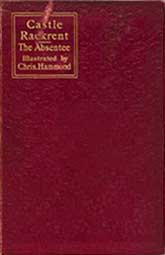Castle Rackrent
 1895 edition
1895 editionFirst publication
1800
Literature form
Novella
Genres
Literary, historical fiction
Writing language
English
Author's country
Ireland
Length
approx. 28,000 words, approx. 34,500 words including glossary
Tales from the big Anglo-Irish house
It's to the credit of Castle Rackrent that it's usually taken to be a novel. By its meagre word count, the text constitutes a novella and—shorn of introduction, footnotes and glossary—barely that.
But Maria Edgeworth's work reads like an old-style historical novel, perhaps the first such work. It's often cited as the prime example of a particularly Irish version of a genre known as the big house novel, narrating as it does the rise and fall of a great ancestral home.
Spanning at least four such generations of "castle" owners, the tale is told by longtime steward Thady Quirk and packs a lot of homespun history into its eighty-odd pages. The aptly named Quirk is a classic early instance of an unreliable narrator. The tone is conversational, starting with that great first paragraph:
Having out of friendship for the family, upon whose estate, praised be Heaven! I and mine have lived rent free time out of mind, voluntarily undertaken to publish the Memoirs of the Rackrent Family, I think it my duty to say a few words, in the first place, concerning myself. My real name is Thady Quirk, though in the family I have always been known by no other than "honest Thady", afterward, in the time of Sir Murtagh, deceased, I remember to hear them calling me "old Thady," and now I've come to "poor Thady"; for I wear a long greatcoat winter and summer, which is very handy, as I never put my arms into the sleeves; they are as good as new, though come Holantide next I've had it these seven years: it holds on by a single button round my neck, cloak fashion.
Notice how much background information is unloaded without ever sounding like a recitation nor giving up the charming, personal voice of the reminiscing servant. It's a voice comparable to that of Laurence Sterne's earlier narrator Tristram Shandy or Emily Brontë's servant Nelly Dean in the later Wuthering Heights, though less densely comedic than the one and less darkly dramatic than the other. In fact, the voice is just one of several layers of narration with a surprisingly sophisticated mode of storytelling.
Softening the blows
In that opening passage is also found something unusual for a work of fiction. A footnote is indicated after the word "greatcoat" and the actual note spreads over the bottom of two pages with more information than you probably want about Thady's style of cloak. Such expository footnotes run through the short novel, purportedly created by another narrator, this one English.
These elements, as well as the book's introduction and glossary, are thought to have been added late to the completed novel to soften the Irish flavour of Quirk's narration, which despite the servant's loyalty manages to satirize the Anglo-Irish landowners.
You see, the multi-generational story is really about the dissipation and decline of a class—the landed gentry represented by the fictional Rackrents (and in actuality Edgeworth's own family).
And at the same time it is less obviously concerned about the rise of the new, upwardly mobile middle class, represented by Quirk's son Jason, who rises from the servant strata, maneuvering to profit from the landowners' distress.
I'm not sure Edgeworth herself saw Castle Rackrent as an exemplar of 1700s-style class warfare and, if she did, I'm not even sure which side she would have been on. That first 1800 edition, coming out the same year as an act of union between England and Ireland, included an "Author's Preface" that softened the book's critique. The author (if she did indeed write the preface) noted the depicted generations of landowners no longer existed and predicted that with the union, the people's Irish identity would eventually be lost. (Not exactly showing political foresight on Edgeworth's part.)
But still the several layers of narration and the unreliability of witnesses in the story's main text end up casting critiques in all directions. No party or parties escape ridicule entirely.
It's terrific getting a literary work that both makes one squirm and thoroughly entertains. Castle Rackrent is for good reason Edgeworth's most popular and acclaimed work.
But it is often bundled in a single volume with the author's later, longer novel, The Absentee (1812), which again takes on the issue of Anglo-Irish landowners, this time however presenting a sympathetic depiction of at least one such figure and a more conventional moral message. The latter novel is not as concisely or engagingly voiced but you may find much to appreciate in The Absentee, as in several of Edgeworth's other post-Rackrent works.
— Eric

